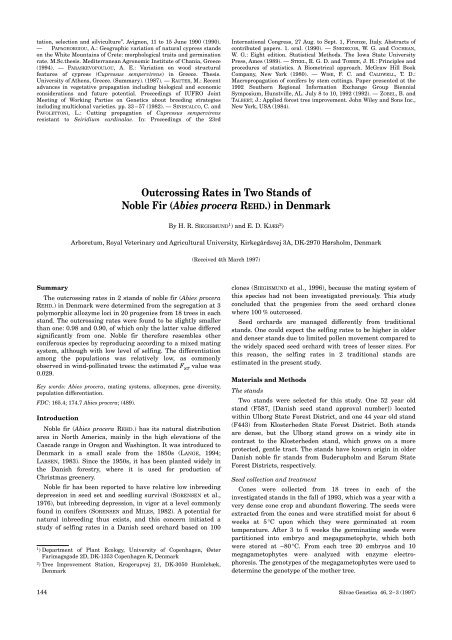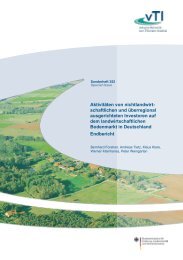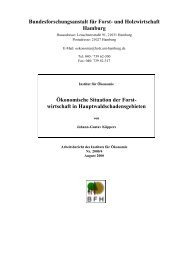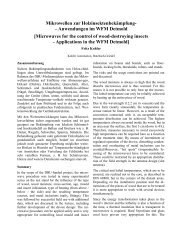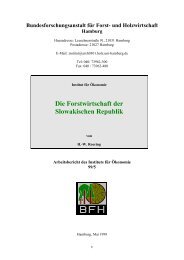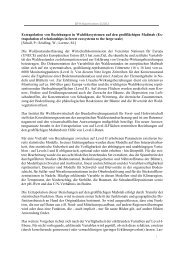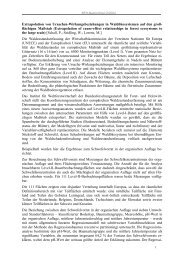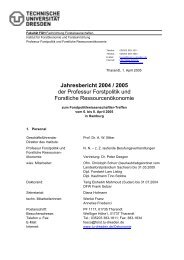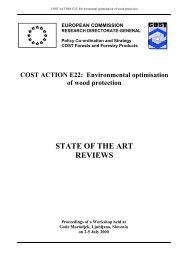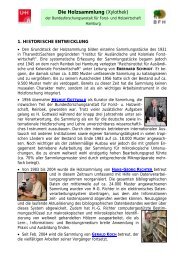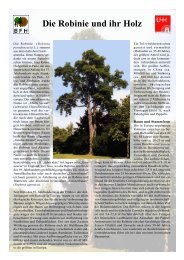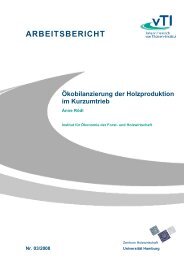Vegetative Propagation of Cupressus sempervirens
Vegetative Propagation of Cupressus sempervirens
Vegetative Propagation of Cupressus sempervirens
You also want an ePaper? Increase the reach of your titles
YUMPU automatically turns print PDFs into web optimized ePapers that Google loves.
tation, selection and silviculture”. Avignon, 11 to 15 June 1990 (1990).<br />
— PAPAGEORGIOU, A.: Geographic variation <strong>of</strong> natural cypress stands<br />
on the White Mountains <strong>of</strong> Crete: morphological traits and germination<br />
rate. M.Sc.thesis. Mediterranean Agronomic Institute <strong>of</strong> Chania, Greece<br />
(1994). — PARASKEVOPOULOU, A. E.: Variation on wood structural<br />
features <strong>of</strong> cypress (<strong>Cupressus</strong> <strong>sempervirens</strong>) in Greece. Thesis.<br />
University <strong>of</strong> Athens, Greece. (Summary). (1987). — RAUTER, M.: Recent<br />
advances in vegetative propagation including biological and economic<br />
considerations and future potential. Proceedings <strong>of</strong> IUFRO Joint<br />
Meeting <strong>of</strong> Working Parties on Genetics about breeding strategies<br />
including multiclonal varieties. pp. 33 – 57 (1982). — SINISCALCO, C. and<br />
PAVOLETTONI, L.: Cutting propagation <strong>of</strong> <strong>Cupressus</strong> <strong>sempervirens</strong><br />
resistant to Seiridium cardinalae. In: Proceedings <strong>of</strong> the 23rd<br />
Summary<br />
The outcrossing rates in 2 stands <strong>of</strong> noble fir (Abies procera<br />
REHD.) in Denmark were determined from the segregation at 3<br />
polymorphic allozyme loci in 20 progenies from 18 trees in each<br />
stand. The outcrossing rates were found to be slightly smaller<br />
than one: 0.98 and 0.90, <strong>of</strong> which only the latter value differed<br />
significantly from one. Noble fir therefore resembles other<br />
coniferous species by reproducing according to a mixed mating<br />
system, although with low level <strong>of</strong> selfing. The differentiation<br />
among the populations was relatively low, as commonly<br />
observed in wind-pollinated trees: the estimated F value was<br />
ST<br />
0.029.<br />
Key words: Abies procera, mating systems, allozymes, gene diversity,<br />
population differentiation.<br />
FDC: 165.4; 174.7 Abies procera; (489).<br />
Introduction<br />
Noble fir (Abies procera REHD.) has its natural distribution<br />
area in North America, mainly in the high elevations <strong>of</strong> the<br />
Cascade range in Oregon and Washington. It was introduced to<br />
Denmark in a small scale from the 1850s (LANGE, 1994;<br />
LARSEN, 1983). Since the 1950s, it has been planted widely in<br />
the Danish forestry, where it is used for production <strong>of</strong><br />
Christmas greenery.<br />
Noble fir has been reported to have relative low inbreeding<br />
depression in seed set and seedling survival (SORENSEN et al.,<br />
1976), but inbreeding depression, in vigor at a level commonly<br />
found in conifers (SORENSEN and MILES, 1982). A potential for<br />
natural inbreeding thus exists, and this concern initiated a<br />
study <strong>of</strong> selfing rates in a Danish seed orchard based on 100<br />
International Congress, 27 Aug. to Sept. 1, Firenze, Italy. Abstracts <strong>of</strong><br />
contributed papers. 1. oral. (1990). — SNEDECOR, W. G. and COCHRAN,<br />
W. G.: Eight edition. Statistical Methods. The Iowa State University<br />
Press, Ames (1989). — STEEL, R. G. D. and TORRIE, J. H.: Principles and<br />
procedures <strong>of</strong> statistics. A Biometrical approach. McGraw Hill Book<br />
Company, New York (1980). — WISE, F. C. and CALDWELL, T. D.:<br />
Macropropagation <strong>of</strong> conifers by stem cuttings. Paper presented at the<br />
1992 Southern Regional Information Exchange Group Biennial<br />
Symposium, Hunstville, AL. July 8 to 10, 1992 (1992). — ZOBEL, B. and<br />
TALBERT, J.: Applied forest tree improvement. John Wiley and Sons Inc.,<br />
New York, USA (1984).<br />
Outcrossing Rates in Two Stands <strong>of</strong><br />
Noble Fir (Abies procera REHD.) in Denmark<br />
By H. R. SIEGISMUND 1 ) and E. D. KJÆR 2 )<br />
Arboretum, Royal Veterinary and Agricultural University, Kirkegårdsvej 3A, DK-2970 Hørsholm, Denmark<br />
1 ) Department <strong>of</strong> Plant Ecology, University <strong>of</strong> Copenhagen, Øster<br />
Farimagsgade 2D, DK-1353 Copenhagen K, Denmark<br />
2 ) Tree Improvement Station, Krogerupvej 21, DK-3050 Humlebæk,<br />
Denmark<br />
(Received 4th March 1997)<br />
clones (SIEGISMUND et al., 1996), because the mating system <strong>of</strong><br />
this species had not been investigated previously. This study<br />
concluded that the progenies from the seed orchard clones<br />
where 100 % outcrossed.<br />
Seed orchards are managed differently from traditional<br />
stands. One could expect the selfing rates to be higher in older<br />
and denser stands due to limited pollen movement compared to<br />
the widely spaced seed orchard with trees <strong>of</strong> lesser sizes. For<br />
this reason, the selfing rates in 2 traditional stands are<br />
estimated in the present study.<br />
Materials and Methods<br />
The stands<br />
Two stands were selected for this study. One 52 year old<br />
stand (F587, [Danish seed stand approval number]) located<br />
within Ulborg State Forest District, and one 44 year old stand<br />
(F443) from Klosterheden State Forest District. Both stands<br />
are dense, but the Ulborg stand grows on a windy site in<br />
contrast to the Klosterheden stand, which grows on a more<br />
protected, gentle tract. The stands have known origin in older<br />
Danish noble fir stands from Buderupholm and Esrum State<br />
Forest Districts, respectively.<br />
Seed collection and treatment<br />
Cones were collected from 18 trees in each <strong>of</strong> the<br />
investigated stands in the fall <strong>of</strong> 1993, which was a year with a<br />
very dense cone crop and abundant flowering. The seeds were<br />
extracted from the cones and were stratified moist for about 6<br />
weeks at 5°C upon which they were germinated at room<br />
temperature. After 3 to 5 weeks the germinating seeds were<br />
partitioned into embryo and megagametophyte, which both<br />
were stored at –80°C. From each tree 20 embryos and 10<br />
megagametophytes were analyzed with enzyme electrophoresis.<br />
The genotypes <strong>of</strong> the megagametophytes were used to<br />
determine the genotype <strong>of</strong> the mother tree.<br />
144 Silvae Genetica 46, 2–3 (1997)


